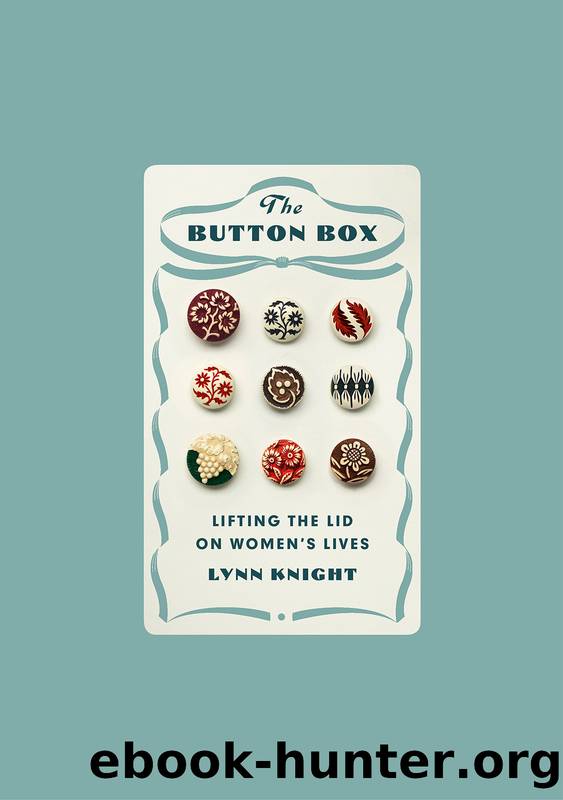The Button Box: Lifting the Lid on Women's Lives by Lynn Knight

Author:Lynn Knight [Knight, Lynn]
Language: eng
Format: epub
Tags: Autobiography, Biography, Customs & Traditions, Design, Fashion & Accessories, Gender Studies, History, Non-Fiction, Personal Memoirs, Social Science, Women, Women's Studies
ISBN: 9781448191536
Google: 09ohCwAAQBAJ
Amazon: 070118891X
Publisher: Random House
Published: 2016-02-18T00:00:00+00:00
16 THE VELVET FLOWERS: HATS
‘IF YOU ARE going to wear a hat at all, be decisive and go the whole hat,’1 Alison Adburgham decreed. Many women have followed that maxim. Chocolate-box confections, cream puffs, galleons, outsize doilies – hats have been many things, including occasions for mirth and music-hall merriment. There are everyday hats, hats that cheer, hats for Sunday best, even hats to steal a march on friends. In Lettice Cooper’s novel The New House (1936) Evelyn is advised by her mother, who has learned a thing or two about keeping up appearances on limited means, that she should ‘have a new winter hat at the very beginning of the autumn, and a new summer hat very early in the spring’.2 That way, friends noticed your new hat while they were still wearing their old ones.
Hats like soup plates were all the rage when my grandma was a young woman. Not only were their circumferences large, their decoration knew no bounds: flowers, fruit, shells – sometimes all at once – plus plumage so extravagant it threatened British birds. The Edwardian taste for things feathered led to the creation in 1904 of the Royal Society for the Protection of Birds to curb millinery excess. A hat Annie wore during this period was relatively restrained, being limited to flowers, but was a whopper nonetheless. At a wedding she attended, the female guests stood some distance apart from one another to accommodate their different headgear. Turner’s department store promised modish styles that were neither ‘extreme nor conspicuous’,3 but definitions of conspicuous change: its advertisement featured hats whose ostrich plumes stood at least eighteen inches proud of the crown.
The velvet flowers that lay on top of my grandma’s buttons when they came to me belong to the 1920s. By this time common sense reigned and hats were now more discreet. The cloche hat was in vogue and women like Annie, who could not afford to buy a new hat each year, let alone each season, decorated their own, applying new trimmings as fashion or fancy dictated. Women’s magazines offered advice on how to trim one hat six different ways; the tills of haberdashery departments rang with purchases of ribbon, braid, and flowers. Eileen Whiteing recalled that hand-made artificial flowers shaped in silk or velvet were ‘quite exquisite’4 back then. The button-box flowers, with their papery green leaf and solid stamens (now, sadly, cracked) were once bright and blooming, and are not unlike the appliqué trim decorating the Victoria & Albert Museum’s pink straw hat made by Kilpin Ltd, circa 1925. Millie Levine recalls with fondness, more than eighty years later, her first grown-up hat, a cloche circled with marigolds.
Whatever their style and function, hats were an essential part of a woman’s wardrobe well into the twentieth century. Hats conferred respectability; to go without was to be improperly dressed. (In the eighteenth century, a top London hotel refused admittance to any woman without a hat.) How to Dress Well was of the opinion that, of all items of clothing, hats performed a ‘diplomatic mission’5 by bringing an outfit together.
Download
This site does not store any files on its server. We only index and link to content provided by other sites. Please contact the content providers to delete copyright contents if any and email us, we'll remove relevant links or contents immediately.
| Advertising | Annuals |
| Book Design | Branding & Logo Design |
| Fashion Design | Illustration |
| Science Illustration |
Wonder by R.J. Palacio(7730)
Unlabel: Selling You Without Selling Out by Marc Ecko(2981)
POP by Steven Heller(2882)
Hidden Persuasion: 33 psychological influence techniques in advertising by Marc Andrews & Matthijs van Leeuwen & Rick van Baaren(2777)
The Pixar Touch by David A. Price(2739)
Ogilvy on Advertising by David Ogilvy(2682)
Drawing Cutting Edge Anatomy by Christopher Hart(2676)
Slugfest by Reed Tucker(2415)
The Art of War Visualized by Jessica Hagy(2412)
The Curated Closet by Anuschka Rees(2385)
Stacked Decks by The Rotenberg Collection(2270)
The Wardrobe Wakeup by Lois Joy Johnson(2233)
365 Days of Wonder by R.J. Palacio(2233)
The Code Book by Simon Singh(2209)
Rapid Viz: A New Method for the Rapid Visualization of Ideas by Kurt Hanks & Larry Belliston(2195)
Tell Me More by Kelly Corrigan(2195)
Keep Going by Austin Kleon(2159)
Tattoo Art by Doralba Picerno(2083)
Tokyo Geek's Guide: Manga, Anime, Gaming, Cosplay, Toys, Idols & More - The Ultimate Guide to Japan's Otaku Culture by Simone Gianni(1945)
